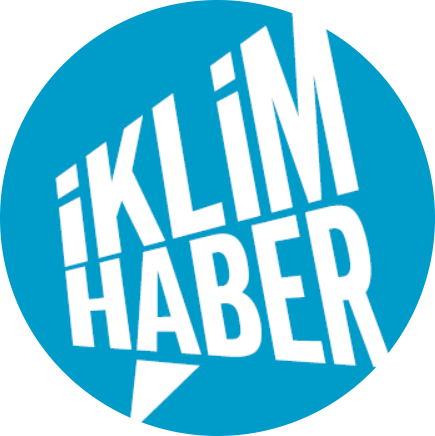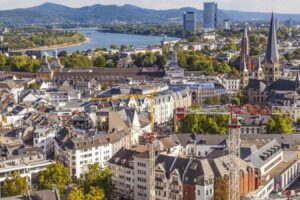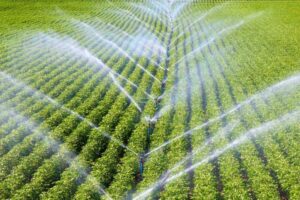TEXT: Sibel BÜLAY
The session on “Circular agriculture for climate emergency” was held on Nov.12th at the Multilevel Action Pavilion. The panel was moderated by Yunus Arikan, Iclei Director of Global Advocacy, who also happens to be a proud citizen of Izmir. Speakers included, Tunç Soyer, Mayor of İzmir Metropolitan Municipality, Turkey; Member of UN Food Systems Champions Network, Şükran Nurlu, Deputy Secretary General, İzmir Metropolitan Municipality, Turkey, Martin Frick, Director of the United Nations World Food Programme Global Office in Berlin, Germany; Deputy to the Special Envoy for the UN Food Systems Summit 2021, Sameh Wahba, Regional Director for Sustainable Development at the Europe and Central Asia Region in the World Bank, Marie-Claire Graf, Climate Youth Negotiators Programme; Member of UN Food Systems Champions Network, Güven Eken, Counsellor to the Mayor of Izmir Metropolitan Municipality, Turkey.
A session on agriculture being hosted by a municipality may seem out of place. But Izmir Mayor Tunç Soyer’s vision is to strengthen the ties between the urban and rural areas of the province, to bring a regional approach to the development of Izmir, as stated in SDG target 11.a. “Support positive economic, social and environmental links between urban, peri-urban and rural areas by strengthening national and regional development planning.” And to address the climate change crisis, the food crisis and sustainable agriculture. And he aims to do all of this through the concept of circular agriculture.
Mayor Soyer’s opening remarks were a gloomy depiction of the situation many of our cities are in today. “We can no longer see circularity in our cites. Cities are cutting their ties with nature and we are losing our grip on reality. We need a new approach that leads to harmony with our planet. How is circularity in urban life possible?” But Mayor Soyer is a very optimistic person, which is reflected in the very positive initiatives he is leading in Izmir and which was shared in this session. In introducing the concept of circularity, Soyer spoke of the interconnectedness of all ecosystems, each nourishing the other.
“Circular culture is based on harmony. Culture is the mortar that binds the building. Circular culture is based on 4 pillars: harmony with each other, with nature, with the past and with change. Harmony with nature is harmony with human nature and the harmony of the city with nature. Harmony with each other focuses on democracy to minimize social inequalities. Harmony with the past: refers to the fact that we can’t design the future without looking to the cultures of the past. And Harmony with change is a way to establish a more just city open to change in alliance with the other cities of the world.
In Izmir we adopted the 4 pillars of circular culture as a concrete strategy to nurture circular urbanism starting from the Mediterranean. In fact, circular culture reflects the common culture of all the peoples of the Mediterranean. We now build a new program for cities of circular culture solidified under Citta Slow Metropolis. We approach cities as an ecosystem that fosters calm and harmony, instead of centrality. This is also the basis for rural development and agricultural policies. It is crucial for us to connect circular agriculture and food systems in an integrated urbanism approach. The Izmir Municipality has integrated food policies and strategies.
Through our circular agriculture strategy we are fighting poverty and climate change. We reinforce basin-level agricultural pianning and in this way ensure food security underpinned by local producer cooperatives. Circular agriculture creates a local food cycle that is healthy, fair and clean for all and nature; changing local food production patterns. Acting alone is never enough. Harmony among our actions is as crucial as harmony with nature. I invite you to join our new initiative: Alliance for Cities with Circular Culture.”
Sameh Wahba “Climate emergency needs a change of approach. It is difficult to get the finance community to finance the unknown; to finance what hasn’t been tested before. The challenge is to incorporate circularity, food and culture into multilevel action. How?
1. Recognition of the role of local governments in guiding the call for circular agriculture
2. Integration between rural and urban areas to transform food systems. (The World Bank has been advocating for a territorial approach for a long time.)
3. Linking cities and the agriculture sector, both of which are deeply affected by the changing climate
“There is a radical overhaul of agriculture and food systems which is being driven by the fact that we are crossing a lot of planetary boundaries. The combination of COVID 19, which completely disrupted supply chains and brought a rethink of proximity, especially on critical issues like food; and at the same time the war in Ukraine which has caused major disruptions in the availability of food items such as wheat and maize; have both caused a huge price inflation affecting food security in many countries, including my own country of Egypt.”
Another issue is the failure of food pricing to take into act the value of water and land. For every dollar spent on food, there is an economic cost of 2 dollars on health and the environmental impact which is unaccounted for. Waste is inadequately priced. There are no incentives to not waste, even as food waste and loss is increasing. But we can valorize food by-products and waste into added value products through composting and energy production.
The good news is that circular economy can transform agriculture. This can be achieved by increasing productivity through optimized resource use; reducing waste and reducing the environmental footprint of the sector.
The World Bank has many initiatives focused on food and agriculture. There is a $342 million project in Turkiye on climate smart agricultural growth. The project presents green approaches to agriculture targeting the protection of soil; the use of renewable energy; managing water pollution; and the management of both fertilizer and pesticide. A new project addressing the nexus of water and agriculture, on modernized irrigation techniques is under development. And the 2020-2025 Action Plan includes initiatives on agriculture and cities, 2 sectors that are critical to decarbonization.
The world population will be 9 billion in 2050, with 80% of food consumed in cities. We will need 3 times the resources, which we don’t have. The World Bank has established a new trust fund: Food Systems 2030. It will leverage $4 Billion in annual lending to build funding for sustainable food systems. But, as Samer stated in the beginning on his talk (“It is difficult to get the finance community to finance the unknown”) the economic case has to be made for financing these initiatives. The value has to be proven. And for this we need analytics. The result of the investment has to be RICH: reliable, inclusive, competitive and healthy food urban systems.
“The transformation of agri-food systems requires strategic investments, anchored in strong collaboration with visionary mayors, practitioners, farmers and academia. And working across all levels of govt.”
EBRD: “Looking globally at food systems, one sees problems of distribution and access. But for 8 billion people, the system does, nonetheless, deliver. The food system is based on old premises: access to cheap fossil fuel based inputs. And the assumption that the world can absorb the environmental degradation associated with unsustainable practices.
But the reality is far from that.
30% of GHG emission are associated with the food system.
30% of the amount of food produced is wasted
30% food is produced by small farmers
33%is the amount of climate finance that goes into sustainable food systems.
My colleague at the World Bank spoke pricing issues. We ask, ‘What are the policy bottlenecks’ in the agri-food sector? What is the bottleneck to creating an infrastructure that addresses food waste? Think about introducing efficient co-logistics. Another bottleneck in the system is that it is not calibrated to reward the return of material into the system, including food waste. Agricultural residue can become an energy source by being converted into biogas. Or it can be returned to the fields, to nourish the soil.
But there is good news: there are lots of initiatives. EBRD has an initiative in Turkiye called “The Secure Economy Platform. There is an e-commerce platform where companies can trade waste materials. There is an Innovation component providing technical assistance to companies to introduce innovative technologies and business models. And there is a knowledge sharing platform. The e-commerce platform is operating at the Interface between the rural areas and the city. Companies are utilizing food waste to produce energy and biochemicals.
The solution that I would like to put on the table here is looking to and removing the bottlenecks; and creating the platforms that bring together all the parties: the financial sector, the private sector, the producers but also crucially, the technology providers and the service providers.”
Şükran Nurlu: “Humans are the only beings on earth that have disrupted the natural order, creating a variety of negative impacts. The climate crisis is one of the impacts, resulting from our disregard for the 4 harmonies that Mayor Soyer spoke of in his opening statement.
We are currently developing the biodiversity map of the province of Izmir. Focusing on the cultivation of local plants. Developing green corridors in the city, providing unbroken access to nature in the city. We have a “Living Parks” project.
In the area of agrculture, we have the “Başka Tarım Mümkün” project which is being translated as circular agriculture. We are providing the youth living in rural areas with services which, till now, have only been available to youth living in cities. We are supporting producer cooperatives and encouraging their growth in scope and number. We are encouraging the use of renewable energy. And stressing the cultivation of local plants.
Finally, we have established the Local Parliament for the European and Mediterranean Region.”
Güven Eken: “Agriculture is one of main sources of GHG emissions. Circular agriculture aims to reduce poverty, produce food, and address adaptation and mitigation measures.
The Izmir Municipality has developed a project whose roots go back 100s, possibly 1000s of years. 20% of the province is vast stretches of grasslands dotted with (mostly olive) trees. Sheep and goats graze on this land. Unfortunately these empty stretches of land look like opportunities to create value by being built-up, or mining the resources they hold. But these tracts of land are sources of food. The trees produce olives and olive oil. The animals grazing on semi-wild ecosystem produce high quality milk and meat.
Unfortunately, as development encroaches upon these grasslands, the number of shepherds has been decreasing steadily. And, along with it, the production of milk and meat. The Municipality of Izmir has begun an initiative designed to increase the attractiveness of animal husbandry as a profession. The Municipality is paying the shepherds, whose animals are only feeding off the grasslands, double the market price of milk and meat. This is justified by the fact that the quality of both the milk and the meat is very high. The milk is then used to produce high quality cheeses which are then sold for double or triple the market price. In this way the cost of the program is borne by the consumer, who is willing to pay a higher price for the higher quality. The program has proven to be both economically and ecologically good for Izmir. There has been an increase in the number of shepherds. The grasslands are being protected as the community begins to understand their value. Consumers have access to safe, quality food products. These animals also produce very high quality fertilizer which is then used on the olive trees and on neighboring agricultural lands where wheat and other products are grown.
The project has yielded enormous climate benefits through emissions avoidance; environmental benefits through the protection of biodiversity and maintaining the integrity of the land and soil; and the economic benefits of animal husbandry as a viable sector in rural areas, along with the cost avoidance in production. Local food production means reduced transport costs and reduced GHG emissions. The costs and transport emissions of animal feed from other areas and countries is avoided. Also avoided is the use of fossil fuel-based fertilizers, which also means the avoidance of GHG emissions associated with their transport from other areas in Turkey and/or other countries. .
How to replicate this initiative? Make basin-wide planning. Study local biota and Identify products which feed each other so that every output becomes an input for the next product. If we can switch from ownership-based to basin-wide agriculture, and make circular planning, we can significantly reduce or totally eliminate GHG emissions.
We can mimic the circularity of ancient agricultural landscapes in the agricultural landscapes of our modern era. Not simple to do, but if this makes a profit for the producer; is good for the climate; and the consumer understands that this is a healthier means of doing agriculture, then we can change the entire paradigm of food production. It can become a friend of the climate, not an enemy.”
Martin Frick: “The climate and agriculture communities have to think together. It is fascinating that it took 27 summits to have food and agriculture squarely in the middle of the climate negotiations. Food as a system is responsible for more than one third of GHG emissions, but it was considered to be too political a topic. We cannot afford to ignore it anymore. But that sounds so negative. Food is the most basic If you visit Izmir, one of the things you will enjoy is the food. Food is who we are, our cultural identity. I don’t want to talk about it as a reason for deforestation. As a consumer of fresh water. As a massive problem. That is only one way to produce food. But there is another way: through building natural capital, based on traditional crops and beautiful landscapes. Think of the vineyards of Tuscany, the olive Trees of Izmir. This is where we need to refind what has been known by our ancestors for a long time: how to do agriculture, how to work with the land. In a way that your children and grandchildren can do as well.
We are in the midst of the worst food crisis since the 2nd World War. 135 million people were acutely food insecure in 2019. COVID disrupted food chains, killed millions and you had many countries going deep into debt. And as of December 2021 there were 276 million people who were acutely food insecure. (The number of people who are malnourished is way higher.) Then came the attack on Ukraine, 5th largest exporter of wheat and now we have 345 million people who are acutely food insecure. We will not be able to fix that if we rely entirely on global food markets. We have to rely on sub-state structures, go back to the local communities; produce food where it is being consumed. Close the circles, and bring cities and nature closer together and find the synergies that existed for many centuries in the hinterland and redefine it. This has 2 components: traditional knowledge , all the knowledge that is there. And the other is all the innovation, digitalization closing the gap between producer and consumers. And with that we can produce food security and livable cities at the same time”
Marie-Claire Graf: “There are 4 different pavilions on food and agriculture. There has never been side event pavilion space on food systems before at a COP. Thankfully after 27 COPS the topic is moving into the implementation space. Finally breaking down the silos and the boundaries. We still have to work hard to bring this into the negotiations. How can we mobilize civil society movements? I myself am a part of so many different movements in agriculture, food systems, climate. There are a lot of gaps, ideas that need to be tested and scaled up. There is a need to reach communities. There is a mismatch in collaboration in scaling initiatives, especially in implementation. We need to involve young people as meaningful decision-makers. But they don’t fit into the traditional structures, they have different ideas, so they are very often left out. Open up and listen to the voice of young people. See how we can work together. More diverse people need to be involved in the decision-making processes. We need to train people to become part of the negotiation process. I am training 60 negotiators from 27 countries to be part of the climate negotiation process. We need much more openness in the climate process. I hope we can build this movement in a positive way, by bringing young people into these processes.”
Şükran Nurlu: “The Izmir Municipality greatly values the participation of youth. We refer to the integration of traditional knowledge and innovation as circular culture. Culture is in everything we do. Through culture we want to achieve harmony with our past. This is the how we can battle climate change and look to the future with hope.
As I said at the start of this article, Mayor Soyer started off on a gloomy note. But there is poetry in his 4 pillars of culture. And there is hope. But beyond hope there is proof, as evidenced by the success of the agricultural initiatives laid out in this session. Proof that we have the means to address the climate crisis and the food security crisis as we improve the livability of our rural areas.”




